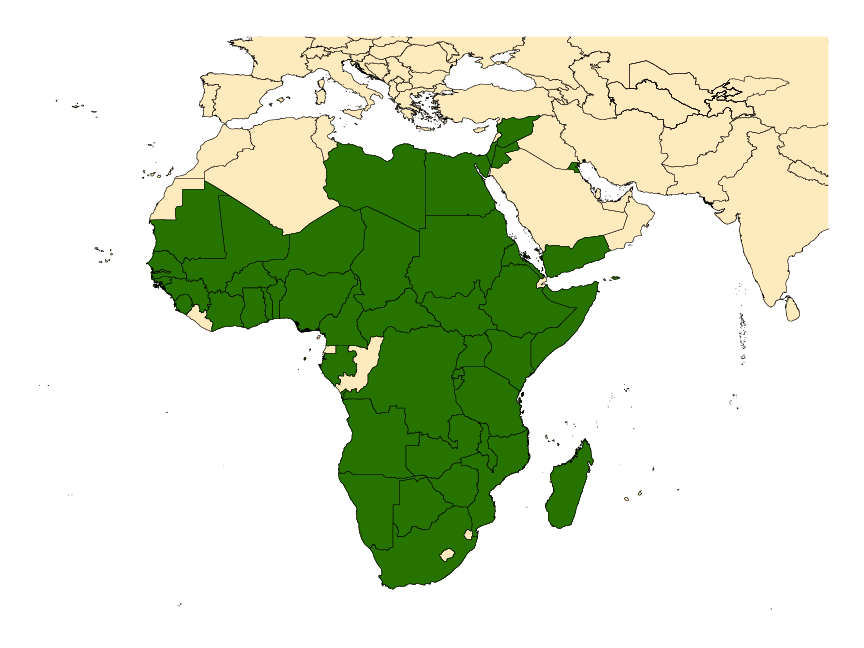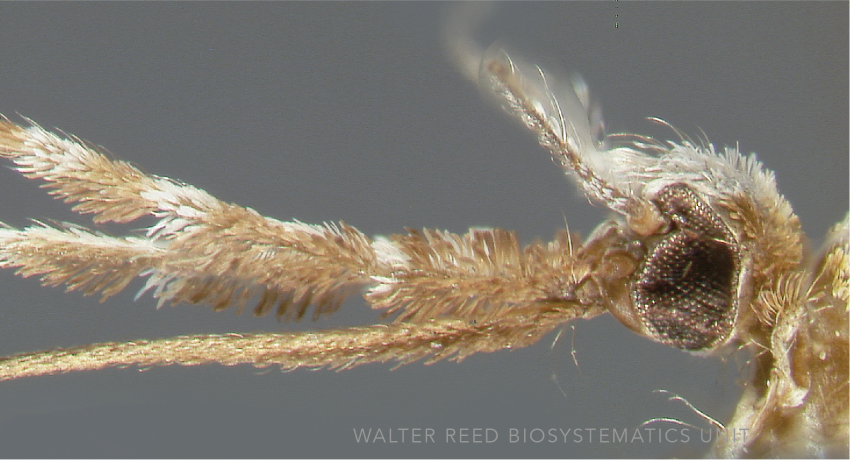MIDDLE EASTERN & AFROTROPICAL REGIONS
Etymology: Pharaohs [land of the]
Anopheles pharoensis, the type species of the subgenus Cellia, is a grayish mosquito with a pale-scaled abdomen sporting dark, laterally-projecting scale tufts. It is informally placed within the Cellia Series together with An. squamosus Theobald among others. Anopheles pharoensis and An. squamosus are the only two African subgenus Cellia species in which larval seta 3-C is strongly branched or dendroid Anopheles pharoensis has four synonyms: albofimbriatus Giles, albus Ventrillon, bozasi Neveu-Lemaire and maculicosta Becker. Cytology studies indicated that populations from Zululand (KwaZulu-Natal, South Africa) exhibit different X-chromosome arrangements and mating incompatibility when compared with other African and topotypic Egyptian populations. This evidence, together with reports of two distinctly variable morphological character states of the larval palmate setae in East Africa, and geographically variable vector status strongly implies the presence of cryptic taxa.
Type locality: Cairo, Egypt
Type depository: Natural History Museum, London, England, United Kingdom (NHMUK)
DIAGNOSTIC CHARACTERS (Click photos to view; mouse over and click large photo to zoom in.)
ADULT (illustrated): Head: Palpus with 4 pale bands. Legs: Ta-I,II5 dark, Ta-III3,4 with dark and pale rings, Ta-III3,4 pale over apical half; Ta-III5 entirely pale. Wing: Costa with at least four dark areas. Abdomen: Terga densely covered with broad pale scales; II–VII-Te with posterolateral dark scale tufts.
LARVA (not illustrated): Head: Seta 3-C dendroid, with single stem divided into ≥8 main branches. Abdominal segments: Palmate setae leaflets either broad, markedly notched with very short filaments (typical form), or much narrower ending in a single long point. Terminal segments: Pecten spines with well-developed spinules.
TAXONOMIC KEYS
Gillies & Coetzee 1987
Glick 1992
Becker et al. 2010
![]()
WRBU - Anopheles - Afrotropical Region - Larva
![]()
WRBU - Anopheles - Western Palearctic Region - Adult
![]()
WRBU - Genera - Global - Adult
![]()
WRBU - Genera - Global - Larva
![]()
WRBU - Genera - Afrotropical - Adult
![]()
WRBU - Genera - Afrotropical - Larva
Exemplar DNA sequences
An. pharoensis COI: MK586011–24, KR014844, KU380430, KU380435, KU380470
BIONOMICS
Immatures
Immature An. pharoensis are found in freshwater ground pools densely populated with reeds, papyrus, or grasses, as well as in muddy pools in rice fields.
Adults
In cultivated areas of the Nile Delta, highly anthropophilic, endophilic populations of An. pharoensis s.s. peak during the warmer summer months. The species is a highly effective malaria vector in Egypt, Cameroon and Senegal, but it is not regarded as a significant vector elsewhere in Africa. In Kenya, human blood indices were as low as 0.16, with the majority of An. pharoensis s.l. blood feeds attributed to cattle.
DISTRIBUTION NOTES
Angola, Benin, Botswana, Burkina Faso, Burundi, Cameroon, Central African Republic, Chad, Côte d'Ivoire, Democratic Republic of the Congo, Egypt, Eritrea, Ethiopia, Gabon, Gambia, Ghana, Guinea, Guinea Bissau, Israel (and Gaza Strip & West Bank), Jordan, Kenya, Kuwait, Libya, Madagascar (includes Glorioso & Juan De Nova Is), Malawi, Mali, Mauritania, Mozambique, Namibia, Niger, Nigeria, Republic of South Africa, Rwanda, São Tomé & Príncipe, Saudi Arabia, Senegal, Sierra Leone, Somalia, South Sudan, Sudan, Syria, Tanzania, Togo, Uganda, Yemen, Zambia, Zimbabwe.

WRBU VECTOR HAZARD REPORTS
None; View other WRBU Vector Hazard Reports
Available GIS Models
IMPORTANT REFERENCES (full citations below)
Theobald 1901a: 169 (M, F*)
Macfie & Ingram 1922 (F*)
Davis 1926 (F*)
Evans 1938: 370 (M, F*, P*, L*, E*)
Ross & Roberts 1943b: 35 (M*, F*, L*; taxonomy, distribution, bionomics)
De Meillon 1947b: 233 (M, F*, L*, E*)
Senevet & Andarelli 1955a: 188 (M*, F*, P*, L, E)
Gillies & De Meillon 1968: 253 (M, F*, L*)
Miles et al. 1983 (genetics; sensu lato)
Gillies & Coetzee 1987 (F*, L*; key, bionomics)
Glick 1992 (F*; key, taxonomy, distribution)
Mudegu & Mukiama 1995 (molecular taxonomy; sensu lato)
Al-Houty 1997 (checklist Kuwait)
Becker et al. 2010: 326 (F*, L*; key, taxonomy, distribution, bionomics)
Kyalo et al. 2017 (distribution; sub-Saharan Africa)
Robert et al. 2019 (distribution; western Palaearctic)
CURRENT SYNONYMS
syn. albofimbriatus Giles
1902: 302 (F*; as variety). Type locality: Tel Lahmul, Palestine (NHMUK).
syn. maculicosta Becker
1903: 69 (F). Type locality: Cairo, Egypt (ZM).
syn. albus Ventrillon
1904: 211 (F). In: Laveran 1904. Type locality: Madagascar (MNHP).
syn. bozasi Neveu-Lemaire
1905a: 32 (F; Nyssorhynchus). Type locality: Doufilé, “Afrique centrale” [White Nile] (PIP). References: Rodhain & Boutonnier 1985: 273 (type depository).
CURRENT SUBSPECIES
None
CITED REFERENCES
Al-Houty, W. (1997) Checklist of the insect fauna of Kuwait. Kuwait Journal of Science and Engineering, 24(1): 145-162.
Becker, N., Petrić, D., Zgomba, M., Boase, C., Madon, M., Dahl, C., & Kaiser, A. (2010). Mosquitoes and their control (Second ed.). Berlin Heidelberg: Springer-Verlag.
Becker, T. (1903). Ägyptische Dipteren. Mitteilungen ans dem Zoologischen Museum in Berlin, 2, 67–195, 4 pls.
Davis, N.C. (1926). Notes on the female hypopygia of anopheline mosquitoes, with special reference to some Brazilian species. American Journal of Hygiene, 6, 1–22.
De Meillon, B. (1947b). The Anophelini of the Ethiopian geographical region. Publications of the South African Institute for Medical Research, 10(49), 1–272.
Evans, A.M. (1938). Mosquitoes of the Ethiopian Region. II. Anophelini adults and early stages. London: British Museum (Natural History).
Giles, G.M. (1902). A handbook of the gnats or mosquitoes giving the anatomy and life history of the Culicidae, together with descriptions of all species notices up to the present date. J. Bale, sons & Danielsson, Limited, London, 530pp.
Gillies, M.T., & Coetzee, M. (1987). A supplement to the Anophelinae of Africa south of the Sahara (Afrotropical Region). Publications of the South African Institute for Medical Research, 55, 1–143.
Gillies, M.T., & de Meillon, B. (1968). The Anophelinae of Africa, south of the Sahara (Ethiopian zoogeographical region). Publications of the South African Institute for Medical Research, 54, 1–343.
Glick, J.I. (1992). Illustrated key to the female Anopheles of southwestern Asia and Egypt (Diptera: Culicidae). Mosquito Systematics, 24(2), 125–153.
Kyalo, D., Amratia, P., Mundia, C.W., Mbogo, C.M., Coetzee, M., & Snow, R.W. (2017). A geo-coded inventory of anophelines in the Afrotropical Region south of the Sahara: 1898–2016. Wellcome Open Research, 2, 57.
Macfie, J.W.S., & Ingram, A. (1922). On the genital armature of the female mosquito. Annals of Tropical Medicine and Parasitology, 16, 157–188.
Miles, S.J., Green, C.A., & Hunt, R.H. (1983). Genetic observations on the taxon Anopheles (Cellia) pharoensis Theobald (Diptera: Culicidae). Journal of Tropical Medicine and Hygiene, 86, 153–157.
Mudegu, J. V., & Mukiama, T. K. (1995). Electrophoretic variation in wild Anopheles pharoensis Theobald in Mwea Irrigation Scheme, Kenya. Insect Science and Its Application, 16(2), 229–231.
Neveu-Lemaire, M. (1905a). Sur un nouveau moustique appartenant a la sous-famille des Anophelinae (Nyssorhynchus) bozasi nov. sp. Comptes Rendus Société de Biologie, 59, 32–33.
Robert, V., Günay, F., Le Goff, G., Boussès, P., Sulesco, T., Khalin, A., Medlock, J.M., Kampen, H., Petrić, D. & F. Schaffner. (2019). Distribution chart for Euro-Mediterranean mosquitoes (western Palaearctic region). Journal of the European Mosquito Control Association, 37, 1–28.
Rodhain, F., & Boutonnier, A. (1985). Checklist of the type specimens of mosquitoes (Diptera: Culicidae) in the medical entomology collections of the Pasteur Institute in Paris. Mosquito Systematics, 16(4), 271–281.
Ross, E.S., & Roberts, H.R. (1943b). Mosquito atlas. Part II. Eighteen old world anophelines important to malaria. Contributions of the American Entomological Institute.
Senevet, G., & Andarelli, L. (1955a). Les Anopheles de l'Afrique du Nord et du Bassin Mediterraneen. Paris.
Theobald, F.V. (1901a). A monograph of the Culicidae or mosquitoes (Vol. 1). London: British Museum (Natural History). [424pp]
Ventrillon, E. (1904). Description de culicides de Madagascar. Bulletin du Muséum national d'histoire naturelle (Paris), 10(1), 550–555.
CITE THIS PAGE
Walter Reed Biosystematics Unit (Year). Anopheles pharoensis species page. Walter Reed Biosystematics Unit Website, http://wrbu.si.edu/vectorspecies/mosquitoes/pharoensis, accessed on [date (e.g. 03 February 2020) when you last viewed the site].










































































































































































